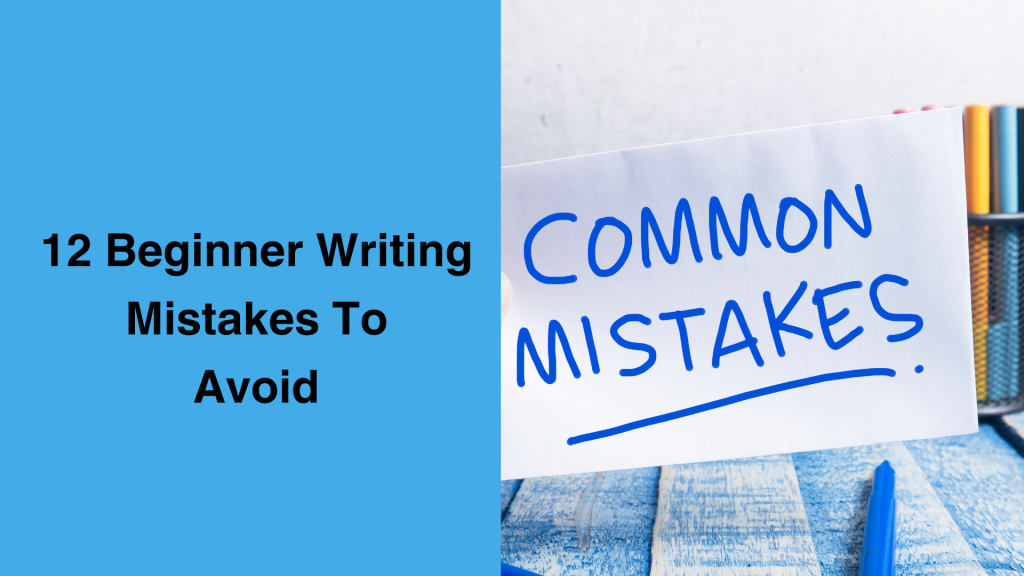12 Common Beginner Writing Mistakes You Must Avoid

Writing is both thrilling and daunting, especially for beginners. As you navigate the winding roads of storytelling, it’s easy to make common mistakes that hurt your work. In this guide, we’ll explore 12 writing mistakes that frequently plague new writers and offer some advice on how to avoid them. So grab your notepad, and we’ll dive into some common beginner writing mistakes.
Top 12 Common Beginner Writing Mistakes

Below, you’ll find some common mistakes beginner writers make and how to help avoid them. While they are more prevalent for newer writers, some are issues even for more experienced authors. The list is in no particular order, as all of these issues can be problematic. Without further ado, let’s get into things.
12. Poor Grammar
Grammar may not be the sexiest aspect of writing, but it’s the backbone that holds your prose together. You don’t have to be perfect, but you need the basics down. Too many simple punctuation errors or run-on sentences will derail even the most compelling narrative.
If you suspect you have issues in this department, I recommend brushing up on general grammar, like sentence structure, commas, semi-colons, and spelling. Aside from that, you should take any feedback from beta readers or agents to heart.
You May Also Like: When To Use Their Vs. There Vs. They’re – Grammar Guide
If someone says, you have a grammatical issue coming up throughout your work, home in on it and fix it. Several tools, such as Grammarly and Purdue OWL, can help you check and correct grammar. The LivingWriter software also has grammar checking and correction built directly into the processor for added convenience.
11. Tense Shifts

“She walked into the room and grabs the book from the shelf. It smelled of dust and old paper, reminding her of her childhood.” Sentences like this shift between past and present tense are common in beginner writers’ work.
You may not even realize that you’re switching between past and present tense, especially if the shift doesn’t happen side-by-side, as in the example. But I promise that your readers will notice. Pick a tense and stick to it like glue. Your readers will appreciate the stability, and your prose will flow smoothly.
10. Jumping between character POVs
Readers may be resilient, but they have their limits. Jumping willy-nilly between different characters’ perspectives can leave readers feeling disoriented and disconnected from the story. Instead, choose one character’s POV and stick with it like a loyal sidekick. Your readers will thank you for the consistency, and your narrative will flow smoother than a well-oiled machine.
If you struggle with this, I recommend you check out my article on POV in writing. It covers different POV styles, how to choose the right one, and tips to stick to it.
9. Info Dumping
Ah, the dreaded info dump—this is precisely what it sounds like. It’s when you dump a large chunk of (usually irrelevant) information on your reader. For example, going in-depth on a character’s entire backstory in the middle of a scene can interrupt the flow of the narrative and bore readers.
Info dumping can occur at any time throughout a narrative. However, it’s often at the story’s start when we feel the need to set the stage with large chunks of information all at once. Don’t dwell on it too long if it’s not vital to the scene’s context.
Instead, sprinkle things in, drop hints, foreshadow, trust your readers to connect the dots, and your story will unfold more organically.
8. Too Many Dialogue Tags/Action Tags

You don’t need a “He said, she said, they said” after every line of dialogue. While they do have their place, you shouldn’t use them excessively. Try to let your characters’ words and actions speak for themselves, and you’ll find your work easier to read and have better dialogue.
You May Also Like: How To Write Dialogue In A Story
Another thing to mention is dialogue tags, which are overly descriptive or flowery. For example, things like “‘I hate you!’ she spat venomously.” or “‘This is amazing!’ he enthused excitedly.” and unnecessary adverbs or adjectives that don’t contribute to the scene. Instead of enhancing the dialogue, they distract from it and make the writing feel dramatic or forced.
7. Repetitive Sentence Starts/Structures
It’s easy to fall into using the same sentence structure throughout your story. This is especially common when using a noun followed by a verb in the first person, such as “He goes, he does, she leaves, they return.” The reading gets monotonous fast when you use this basic sentence structure.
Even if different things are happening, it begins to feel as if you’re reading the same sentence (or a variation) repeatedly. This is because you are. As the writer, try to play with your language a bit more. Take a repetitive sentence like this:
“He walks down the street every morning, he nods to his neighbors, and he sips his coffee at the corner café.”
Now, let’s give it some variety.
“Every morning, he strolls down the street, exchanging nods with his neighbors, and savors his coffee at the corner café.”
Here, I’ve varied the sentence structure by starting with a different phrase (“Every morning”) and using gerunds (“strolling,” “exchanging,” “savoring”) instead of simple verbs. This adds variety and flow to the sentence, making it more engaging for the reader.
What Is A Gerund?
I mentioned using gerunds above. So, I wanted to give a quick definition for those who aren’t familiar. A gerund is a form of a verb that functions as a noun in a sentence. It is created by adding the suffix “-ing” to the base form of a verb.
Gerunds can be used as subjects, objects, or complements in a sentence. For example:
- Swimming is my favorite hobby. (Here, “swimming” is a gerund functioning as the sentence’s subject.)
- I enjoy reading books. (Here, “reading” is a gerund functioning as the object of the verb “enjoy.”)
- Her favorite activity is dancing. (Here, “dancing” is a gerund functioning as the complement of the verb “is.”)
They are a great way to add variety to sentence structure and can help writers avoid repetitive language.
6. Melodrama
Melodrama refers to an exaggerated, overly emotional, or sensationalized storytelling style. Melodramatic writing or scenes often feature characters expressing intense emotions, dramatic plot twists, and heightened conflict in a way that may seem unrealistic, overly theatrical, and out of place.
Imagine you’re watching a movie, and suddenly, a scene that feels like it came from a soap opera comes in. Not only does this come across as clichéd or lacking in subtlety, but it also creates some whiplash for readers. If you use melodrama, ensure your story and characters support it from the start. If not, it will detract from the quality of the story.
Overall, subtlety is your friend. Let your characters’ emotions speak for themselves without resorting to over-the-top theatrics.
5. Filler
Filler scenes are an insidious issue that can be hard to recognize and eliminate. It often shows up as too much description, description of things that aren’t serving the story, or too much “connect the dots” material where characters go from place to place or have unimportant conversations.
Many filer scenes can leave your story feeling stuck in neutral, spinning its wheels without progressing forward. Whether it’s unnecessary backstory, meandering dialogue, or superfluous descriptions, filler has a knack for sucking the life out of your narrative and messing up your pace.
Try to identify sections that aren’t strictly needed or could be said more concisely. Trim the fat, focus on what’s essential, and your readers, pace, and overall story will thank you.
4. No Sub-Plot
Sun-plots are unsung storytelling heroes that add depth, complexity, and intrigue to your narrative. A good core “A plot” is a must. But even if you do everything right with it, it often isn’t enough for a compelling, rich story all by itself. Stories with no meaningful sub-plot to speak of frequently have pacing issues, are too short, or rely on filler for content.
To avoid this, be sure you have some secondary plot points. You can do this the same way you would a central plot. Start by brainstorming secondary storylines that intersect with the primary plot but offer unique perspectives, character development opportunities, or thematic exploration. These subplots can revolve around supporting characters’ arcs, introduce new challenges or conflicts, or delve into backstory elements that add depth to the narrative.
3. Poor Pacing

Pacing is mentioned anytime you discuss common beginner writing mistakes, and it continues to be an issue for even more experienced writers. In other words, this is a big one. Let’s start by explaining pacing. It’s essentially the speed at which your story unfolds. It is the heartbeat of your story, dictating the ebb and flow of tension and release that keeps readers engaged.
Many of the issues we’ve already covered play into the pacing of your story. Unnecessary or drawn-out scenes are common issues that slow the pace down to crawl and kill the story’s tension. On the other hand, a very fast pace isn’t always better.
For example, as mentioned above, if you don’t have enough going on, the story can move too fast from one thing to another and feel anti-climactic. Beyond this, readers (and characters) need an ebb and flow, a tension-building followed by a release period. Using story structures, like the three-act structure, can help keep you on track.
You May Also Like: Mastering Pacing In Novels And Screenplays
Whether you’re sprinting through action-packed scenes or luxuriating in moments of quiet introspection, finding the right rhythm can be a delicate balancing act. Take care to build tension and vary the pace to keep readers engaged, and your story will unfold with grace and keep readers reading until the final page.
2. Using Characters To Convey Information Cheaply
Imagine a scene where two characters sit at a café discussing their childhoods in meticulous detail, solely for the reader’s benefit. Not only is this unrealistic, but it’s also uninteresting. Characters shouldn’t feel like walking encyclopedias or therapists— their primary role is to engage in meaningful interactions that drive the plot forward and reveal their personalities through action and dialogue.
Avoid characters who exist solely to fulfill a plot’s needs conveniently. Likewise, throwing too many characters into the mix can turn your narrative into a confusing jumble of names and faces. Treat your characters like real people, giving them depth, motivation, and agency. Your readers will appreciate the authenticity, and your story will resonate on a deeper level.
1. Flat, Generic Characters
One of the most common pitfalls for beginner writers is creating flat, generic characters in the story’s world without any depth or real purpose. These characters lack the complexity, agency, and relatability to captivate readers and drive the narrative forward.
To avoid this mistake, it’s essential to invest time in developing well-rounded characters with distinct personalities, motivations, and flaws from the beginning. If you can replace your main character with another person and the plot plays out similarly, you should reevaluate their depth.
You May Also Like: How To Write Unique Characters With LivingWriter
Furthermore, good secondary characters are crucial in developing a personality beyond the main protagonist. Meaningful relationships, conflicts, and interactions between secondary characters help enrich the story’s tapestry and give context to the protagonist’s journey.
They offer diverse perspectives, motivations, and goals, creating a more immersive and dynamic narrative. Through their interactions with one another and the main character, secondary characters can reveal nuances of the story’s world, culture, and societal norms, adding realism and complexity to the storytelling experience.
Conclusion
And there you have it—12 common writing mistakes that every beginner should strive to avoid. Writing is a journey of discovery, and while missteps are inevitable, learning from them is the key to growth. So arm yourself with these insights, embrace the adventure, and remember: every mistake is an opportunity to sharpen your skills and craft stories that captivate hearts and minds. Happy writing!